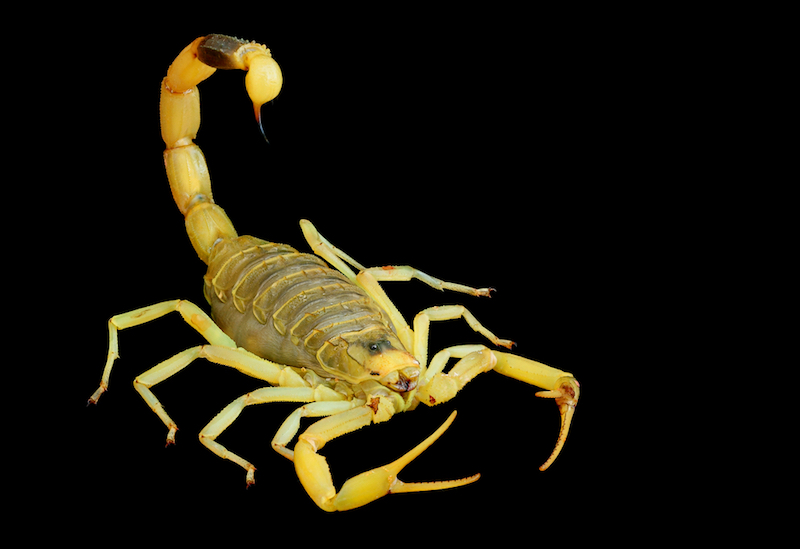'Deathstalker' Scorpion's Rapid Strike Caught on Film

One of the world's deadliest scorpions has an impressive and poisonous strike that helps the creature defend itself against attacks, and scientists recently recorded the aggressive maneuver for the first time.
Known as the "deathstalker" scorpion, Leiurus quinquestriatus is a nearly 4-inch-long (10 centimeters) scorpion with venom that contains large amounts of toxins. The deathstalker was one of seven scorpion species filmed for a new study on the speed of a scorpion's sting. And the deathstalker topped the others with its swift strike, the scientists discovered. According to the researchers' findings, the deathstalker snapped at 51 inches (130 cm) per second — nearly 3 miles per hour (5 km/h).
Beyond helping researchers understand the deadly deathstalker's sting, the study revealed that scorpions have a variety of strike styles. For instance, some scorpion species take direct aim at their targets, while other scorpions move their tails in a more circular motion. [In Photos: The Amazing Arachnids of the World]
"We found that different 'tail' shapes appear to permit different strike performances," study senior author Arie van der Meijden, a biologist and postdoctoral researcher at the University of Porto in Portugal, told Agence France-Presse (AFP).
The researchers noted that there arenearly 2,500 species of scorpions in the world, and their venomous tails differ in size and shape. The "tail" of a scorpion is actually a continuation of the creature's body; only the stinger at the end is a true tail. Scorpions sting their prey, a slow and precise movement, but the arachnids also sting in defense. These defensive strikes are what greatly differ among scorpion species, the researchers said.
In the new study, each scorpion was placed on a small platform surrounded by mirrors. A thin piece of wire was used to prompt the scorpion's sting, which was filmed from above at a rate of 500 frames per second. The video footage was then used to create 3D models of the sting, allowing the researchers to see how varied the strike patterns are.
While their results showed that the speed and shape of a defensive tail strike may depend on the scorpion's species, body size and tail shape, the reason for such variation among scorpions is still unknown, the scientists said.
Sign up for the Live Science daily newsletter now
Get the world’s most fascinating discoveries delivered straight to your inbox.
The next step in this research will be to determine why defensive strikes vary among species, which van der Meijden told the AFP may be due to the different predators each species faces."Some tail strikes were 'closed,' almost returning to the start position, while others were more 'open,' with the start point and the end point further from each other," the researchers explained in their study. "More 'open' shapes were faster than more 'closed' shapes."
The researchers detailed their findings in a study published online April 3 in the journal Functional Ecology.
Original article on Live Science.










